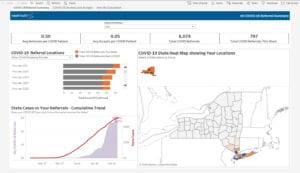Transitioning elderly patients from acute care facilities continues to be inefficient, inconvenient, and fraught with risk. Most are still done via paper and fax machines. In addition, the decision on the patient’s most appropriate next level of care is often made without using patient data or using only superficial information like primary diagnosis. It shouldn’t be this way.
naviHealth is a company that makes a technology platform that uses evidence-based protocols along with dedicated staff to track patient recoveries, manage hospital discharges and improve clinical decision making. Their goal is to help build a future with more senior-centered care.
 I recently had the opportunity to sit down with Jay LaBine MD, Chief Medical Officer at naviHealth. We discussed how decisions are made when transitioning patients to post-acute care, the future of homecare, and the overall lack of investment in this area.
I recently had the opportunity to sit down with Jay LaBine MD, Chief Medical Officer at naviHealth. We discussed how decisions are made when transitioning patients to post-acute care, the future of homecare, and the overall lack of investment in this area.
Determining Next Level of Care
“The first part of the care transition is determining what’s the most appropriate next level of care setting for that individual,” stated Dr. LaBine. “But how is that determination made?”
The answer is that it depends on the insurance company, provider organization and patient involved. There is no single standardized process for making that determination. Surprisingly, very little data is used to make this decision. You would think the specifics of the patient’s condition would always be factored in, like whether they use a walker or how much help they need to do the prescribed physiotherapy. Sadly, however, these are not common considerations.
 “At naviHealth we work with customers – hospitals and health plans – to help put more rigor behind that choice,” continued Dr. LaBine. “We have a proprietary care planning tool that uses data to make that decision. The data we input is the functional condition of a particular patient versus just their primary diagnosis.”
“At naviHealth we work with customers – hospitals and health plans – to help put more rigor behind that choice,” continued Dr. LaBine. “We have a proprietary care planning tool that uses data to make that decision. The data we input is the functional condition of a particular patient versus just their primary diagnosis.”
Dr. LaBine stressed the importance of helping hospitals understand and take responsibility for ensuring patients get the appropriate next level of care: “The people making that decision need help.” Using data from the patient’s medical record and matching them to the next level of care based on evidenced-based pathways is far superior to manual methods.
The Future of Homecare
During our conversation, it wasn’t difficult to see Dr. LaBine’s passion for improving senior care. He shared his vision for a better future, where seniors get to “shop” for care solutions that are best for them. He noted that Nursing Home Compare (part of Medicare.gov) is a sub-par experience and lacks the right data to really help seniors and their families. Dr. LaBine stressed the importance of providing seniors with a place where they can go online and pick a plan and place that meets their needs – similar to the way they pick their medicare plans today.
Dr. LaBine is a big believer in homecare and aging in place. With the constant improvements being made to at-home medical devices and patient-usability, a larger number of seniors can stay at home longer. Not only would this be a better experience for them, it would also help reduce the cost of care and relieve some of the stress on the healthcare system.
“House calls” – long a relic of healthcare history – are now starting to make a comeback. The trend has only accelerated due to COVID-19 which has forced many seniors to remain sheltered in place even as their communities open up. Meeting these patients where they are through telemedicine (virtual care) or actual in-person visits is exactly what is needed.
Lack of Investment
Over the past year, I have spoken with a number of companies who have solutions aimed at improving the efficiency and safety of transitioning from acute care to post-acute settings. One of the questions I always ask is “Why has this not been solved already?”
The answer always comes back the same – no one wants to invest in solving the problem.
This is partly because there is no consistency in the person who is responsible for care transitions. In some organizations it is the discharge department. In others it is case managers. Sometimes the Chief Medical Officer will make it a special project or priority. This variation between organizations makes it difficult for solution providers to navigate to the “right person” who can make a purchasing decision. This leads to slower adoption.
Until recently, there has not been a compelling financial incentive to fix the issue. There has always been a patient safety driver and a patient experience reason to invest in care transitions, but without a financial hammer, project requests in this area would often fall lower on the priority list. With the penalties introduced by CMS for readmissions, however, there is now a stronger financial case to be made.
Although progress is being made, investment in care transitions is still lacking in my opinion. That’s why it’s so is nice to see companies like naviHealth growing and succeeding in this space.
Watch the full interview with Dr. LaBine to learn more about:
- Transition of care pre- and post-COVID-19
- The role Medicare plays in transition of care
- How increasing transparency can lead to faster senior care improvements
- The two most important things for a hospital CEO when it comes to transition of care
- Why it’s important to invest in the care model and not just the technology
This article is part of the #HealthIT100in100
To learn more about NaviHealth visit www.navihealth.com.
Listen and subscribe to the Healthcare IT Today Interviews Podcast to hear all the latest insights from experts in healthcare IT.
And for an exclusive look at our top stories, subscribe to our newsletter.
Tell us what you think. Contact us here or on Twitter at @hcitoday. And if you’re interested in advertising with us, check out our various advertising packages and request our media Kit.













